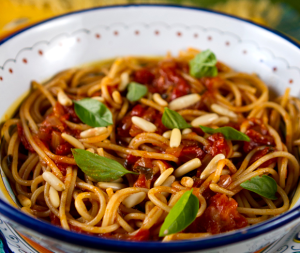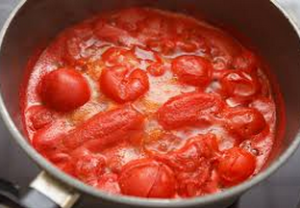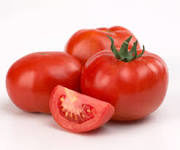Boosts Your Lycopene, Antioxidants, Vitamins & Attractiveness
By Dina Eliash Robinson
Artists As Gardeners
Our famous friends, musicians and travel journalists Joanne (Giovanna) and Tony DiBona, are keeping us supplied with some of the most delicious organic vegetables and herbs, plucked from their garden, fresh and fragrant, whenever we visit each other. Suspecting that there was more than green thumbs involved in the mystery of a garden yielding evermore edible riches year after year—even during its gardeners’ absences while they are touring with their troupe of musical performers or away on assignment as travel writers, photographers and video producers. (You can find their work at http://www.romanholidaymusic.com and http://www.getthepicturetravel.com/—weeventually solved the mystery by watching the gentle care with which they tended each sprig and plant, selected each fresh ingredient just at the right time of its prime for salads and the mouthwatering cooked meals the prepared: The secret ingredient was, and is amore.
and the mouthwatering cooked meals the prepared: The secret ingredient was, and is amore.
Only love (in this case, I suspect, it is the passionate Italian kind) could elicit such grateful reciprocity from the various species of tomatoes, peppers, other veggies and flavorful herbs overflowing the DiBona garden. Aha! I said, and have ever since been wooing my produce with that powerful ingredient, while preparing meals mindfully, with grateful affection for the living plants that nourish and heal us. Although we might not attain the level of stamina our younger friends have as they hike and cycle up mountains, swim with whale sharks and Galapagos tortoises and traipse around the cultural sights of Europe, Asia, Alaska, we are at least hopeful and have fun building up our own oomph! .
Lycopene Magic
The last basketful of tomatoes pressed upon us recently as we were leaving Villa DiBona, were extraordinary in several aspects. They were round, medium to smallish size (about two or three times the size of cherry tomatoes), deep red—almost Burgundy wine color—inside and out, unusually robust in flavor, but most notably, their skin was quite a bit thicker than that of any other tomato we have tasted. Since Tony had planted various strains—among them Beefmaster, Better Bush Hybrid and Celebrity—he attributed their evolving into such “super tomatoes” to his compost-fed soil and San Diego’s gentle, sunny climate.
Improvised Recipe: Blessed with a sensitive palate, I could taste the bold surge of flavors even in the raw tomato, although their intensity (and nutrients, of course) multiplied in the stewed tomatoes. But since my taste buds are also partial to strong flavors, I sauté fresh, chopped garlic in olive oil first, adding and cooking  the tomatoes with a little spring water, thus releasing the fat-soluble lycopene’s bioavailability. (More about this later.) Still not ready to leave well enough alone, I tear up several fresh basil leaves and add to the mix, sprinkle a shake of cayenne pepper, simmer for 30 or more seconds and serve over pasta, with a dollop of goat cream cheese on top—a pretty decoration until it melts and is blended into the dish. You’ll find no need for salt—and if you keep portions reasonably small, this rich tasting, healthy dish won’t bust your waistline.
the tomatoes with a little spring water, thus releasing the fat-soluble lycopene’s bioavailability. (More about this later.) Still not ready to leave well enough alone, I tear up several fresh basil leaves and add to the mix, sprinkle a shake of cayenne pepper, simmer for 30 or more seconds and serve over pasta, with a dollop of goat cream cheese on top—a pretty decoration until it melts and is blended into the dish. You’ll find no need for salt—and if you keep portions reasonably small, this rich tasting, healthy dish won’t bust your waistline.
Lycopene Story
While luxuriating in the sensuous complexities of this (mistakenly believed to be simple) dish, my mind shouted Lycopene! as it tapped into a vivid memory of Faraj, a Persian friend we had in New York City years ago, whose passion for food equaled that for his profession as an antiques dealer. Not satisfied with merely being a fine gourmet cook, he went into the business of buying tomato peels by the ton from companies that produced canned or jarred sauces, paste, juices and other peeled and preserved versions of this luscious fruit. (Yes, fruit, not a vegetable as most of us think of it and use as.)
Having been raised in the Middle East, the enterprising young man was well aware of tomato’s many health benefits as a source of antioxidants and vitamins—especially Vitamin C—in addition to lycopene. But choosing to trade in the peels, which were undervalued and often discarded in the 1970s, turned out to be a smart move. Faraj arranged to have the tomato peels dehydrated, compacted, packaged and shipped to Hong Kong, where he contracted a natural healing products lab to process them into Lycopene supplements. He then set up a network of distributors who sold these capsules to vitamin and health food stores around the world.
Love Apple—Not For Sex Alone
Known in ancient Greece and other Mediterranean countries as Love Apple, for what was believed to be its powerful aphrodisiac qualities, the tomato was soon discovered to also be a source of antioxidants which protect DNA and other cells from dangerous free radicals, as well as a treasure-trove of vitamins—as we mentioned above, especially Vitamin C—and various other health benefits.
In fact, a recent issue of The Harvard Health Letter quotes Dr. Edward Giovannuci, professor of nutrition and epidemiology at the Harvard School of Public Health, that “… lycopene may have specific properties that protect the cell in a way other antioxidants may not.” Dr. Giovannuci—along with a team of Finnish researchers reporting in the journal Neurology—also sees evidence of lycopene lowering the risk of strokes. Adding more health benefits, lycopene, as a micronutrient, has been found to provide protection against prostate and various epithelial* cancers (* i.e. of tissues that cover the body and internal organs).
While supplements do help to boost lycopene levels, it is far easier for the body to absorb it from foods. And as Dr. Giovannuci points out, since it is fat soluble, lycopene’s optimum bioavailability can be obtained by adding olive oil to cooked tomatoes. He also assures us that while there is no need to overdo it (a little goes a long way), there is no evidence of potential toxicity from a lycopene-rich diet.
There is, however, one caveat: My research shows that the “nightshades” family of plants—which includes tomatoes, as well as peppers, eggplants and potatoes (though surprisingly not sweet potatoes and yams)—tend to increase the negative effects of arthritis. Sufferers, therefore, should either eliminate nightshades produce from their diet, or indulge very rarely, in small amounts and only consume the plants that seem to trigger the leas discomfort or harm to their condition.
To paraphrase the adage about ‘all good things…’ not only is moderation advised, but since we are omnivores, a well-balanced diet is also of utmost importance.

